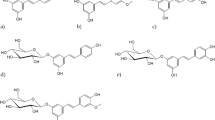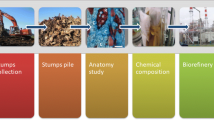Abstract
Acetone-soluble compounds found in different root zones and stumps of Norway spruce (Picea abies [L.] Karst), which were grown on either peatland or a mineral soil site, were studied. Samples from stumps and roots of different sizes and ages were collected a day after the trees were felled. The wood and bark of stumps and three zones of the roots were separated and extracted with acetone in an ultrasonic bath. Extracts were silylated and analysed by gas chromatography–mass spectrometry. The stilbene glucosides astringin and isorhapontin were major compounds in the spruce bark samples. The resveratrol glucoside piceid and the flavonoid catechin were also extracted from spruce bark. We also found the lignan hydroxymatairesinol in some wood extracts. Total concentrations of stilbene glucosides in bark of stumps and different root zones varied between 0.53 and 8.29 % (w/w, dry weight) with isorhapontin being the major compound. Isorhapontin concentrations were highest in the spruce samples grown on mineral soil. The bark of the roots close to the stem is a rich source of stilbenes for commercial utilisation.






Similar content being viewed by others
References
Aritomi M, Donnelly D (1976) Stilbene glucosides in the bark of Picea sitchensis. Phytochemistry 15:2006–2008
Balas A, Popa V (2007) On characterization of some bioactive compounds extracted from Picea abies bark. Rom Biotechnol Lett 12:3209–3216
Beyer U, Tesche M, Heller W, Sandermann H (1993) Fungistatic effectiveness of phenolic compounds in Norway spruce (Picea abies) and the effect of SO2. Forstwissenschaftliches Centralblatt 112:251–256
Chong J, Poutaraud A, Hugueney P (2009) Metabolism and roles of stilbenes in plants. Plant Sci 177:143–155
Co M, Fagerlund A, Engman L, Sunnerheim K, Sjöberg P, Turner C (2011) Extraction of antioxidants from spruce (Picea abies) bark using eco-friendly solvents. Phytochem Anal. doi:10.1002/pca.1316
Ekman R (1979) Distribution of lignans in Norway spruce. Acta Acad Abo Ser B 39:1–6
Evensen P, Solheim H, Hoiland K, Stenersen J (2000) Induced resistance of Norway spruce, variation of phenolic compounds and their effects on fungal pathogens. Forest Pathol 30:97–108
Hammerbacher A, Ralph S, Boehlmann J, Fenning T, Gershenzon J, Schmidt A (2011) Biosynthesis of the major tetrahydroxystilbenes in spruce, astringin and isorhapontin, proceeds via resveratrol and is enhanced by fungal infection. Plant Physiol 157:876–890
Hovelstadt H, Leirset I, Oyaas K, Fiksdahl A (2006) Screening analyses of stilbenes, resin acids and lignans in Norwegian conifers. Molecules 11:103–114
Li S-H, Niu X-M, Zahn S, Gershenzon J, Weston J, Schneider B (2008) Diastereomeric stilbene glucoside dimers from the bark of Norway spruce (Picea abies). Phytochemistry 69:772–782
Lindberg M, Lundgren L, Gref R, Johansson M (1992) Stilbenes and resin acids in relation to the penetration of Heterobasidion annosum through the bark of Picea abies. Eur J For Pathol 22:95–106
Mannila E, Talvitie A (1992) Stilbenes from Picea abies bark. Phytochemistry 31:3288–3289
Mérillon JM, Fauconneau B, Teguo PW, Barrier L, Vercauteren J, Huguet F (1997) Antioxidant activity of the stilbene astringin, newly extracted from Vitis vinifera cell cultures. Clin Chem 43:1092–1093
Münzenberger B, Heilemann J, Strack D, Kottke I, Oberwinkler F (1990) Phenolics of mycorrhizas and non-mycorrhizal roots of Norway spruce. Planta 182:142–148
Päivänen J, Paavilainen E (1996) Forestry in peatlands. In: Vasander H, (ed.), Peatlands in Finland. Finnish Peatland Society. ISBN 952-90-7971-0, pp 72–83
Pan H, Lundgren L (1995) Phenolic extractives from root bark of Picea abies. Phytochemistry 39:1423–1428
Piispanen R, Willför S, Saranpää P, Holmbom B (2008) Variation of lignans in Norway spruce (Picea abies [L.] Karst) knotwood: within-stem variation and the effect of fertilization at two experimental sites in Finland. Trees 22:317–328
Repo A, Tuomi M, Liski J (2011) Indirect carbon dioxide emissions from producing bioenergy from forest harvest residues. GCB Bioenergy 3:107–115
Shibutani S, Samejima M, Doi S (2004) Effects of stilbenes from bark of Picea glehnii (Sieb. et Zucc) and their related compounds against feeding behaviour of Reticulitermes speratus (Kolbe). J Wood Sci 50:439–444
Solhaug K (1990) Stilbene glucosides in bark and needles from Picea species. Scand J For Res 5:59–67
Strack D, Heilemann J, Wray V, Dirks H (1989) Structures and accumulation patterns of soluble and insoluble phenolics from Norway spruce needles. Phytochemistry 8:2071–2078
Toscano Underwood C, Pearce R (1991) Astringin and isorhapontin distribution in Sitka spruce trees. Phytochemistry 30:2183–2189
Viiri H, Annila A, Kitunen V (2001) Induced responses in stilbenes and terpenes in fertilized Norway spruce after inoculation with blue-stain fungus Ceratocystis polonica. Trees 15:112–122
Wang H, Liu L, Guo Y-X, Dong Y-S, Zhang D-J, Xiu Z-L (2007) Biotransformation of piceid in Polygonum cuspidatum to resveratrol by Aspergillus oryzae. Appl Microbiol Biotechnol 75:763–768
Willför S, Nisula L, Hemming J, Reunanen M, Holmbom B (2004) Bioactive phenolic substances in industrially important tree species. Part 1: knots and stemwood of different spruce species. Holzforschung 58:335–344
Woodward S, Pearce RB (1988) The role of stilbenes in resistance of Sitka spruce (Picea sitchensis (Bong) Carr.) to entry of fungal pathogens. Physiol Mol Plant Pathol 33:127–149
Zeneli G, Krokene P, Christiansen E, Krekling T, Gershenzon J (2006) Methyl jasmonate treatment of mature Norway spruce (Picea abies) trees increases the accumulation of terpenoid resin components and protects against infection by Ceratocystis polonica, a bark beetle-associated fungus. Tree Physiol 26:977–988
Zhang L, Gellerstedt G (2008) 2D Heteronuclear (1H–13C) Single Quantum Correlation (HSQC) NMR analysis of Norway spruce bark components. In: Hu T (ed), Characterization of lignocellulosic materials. Blackwell Publishing Ltd., Oxford. ISBN: 978-1-405-15880-0, pp 3–16
Acknowledgments
This work is part of the Forestcluster Ltd’s Future Biorefinery Program, FuBio. We would like to thank M.Sc. Tuuli Pihlajamaa and M.Sc. Duong-Thuy Phan for their technical assistance.
Author information
Authors and Affiliations
Corresponding author
Additional information
Communicated by D. Treutter.
Rights and permissions
About this article
Cite this article
Latva-Mäenpää, H., Laakso, T., Sarjala, T. et al. Variation of stilbene glucosides in bark extracts obtained from roots and stumps of Norway spruce (Picea abies [L.] Karst.). Trees 27, 131–139 (2013). https://doi.org/10.1007/s00468-012-0780-x
Received:
Revised:
Accepted:
Published:
Issue Date:
DOI: https://doi.org/10.1007/s00468-012-0780-x




